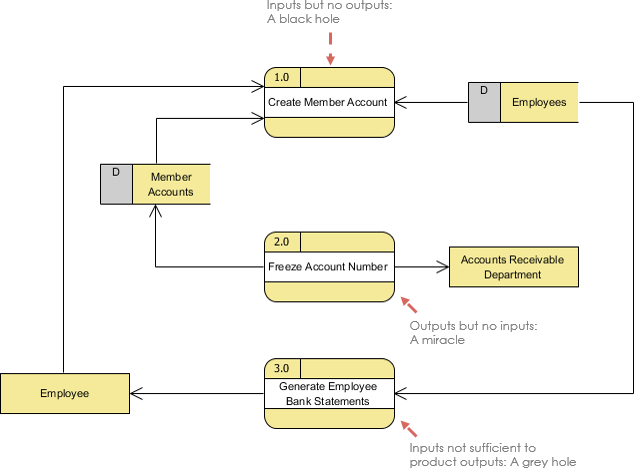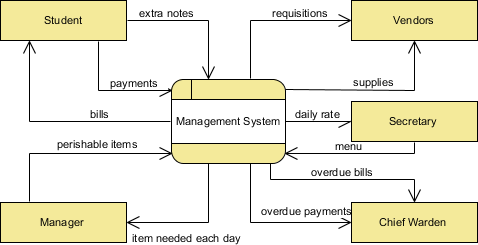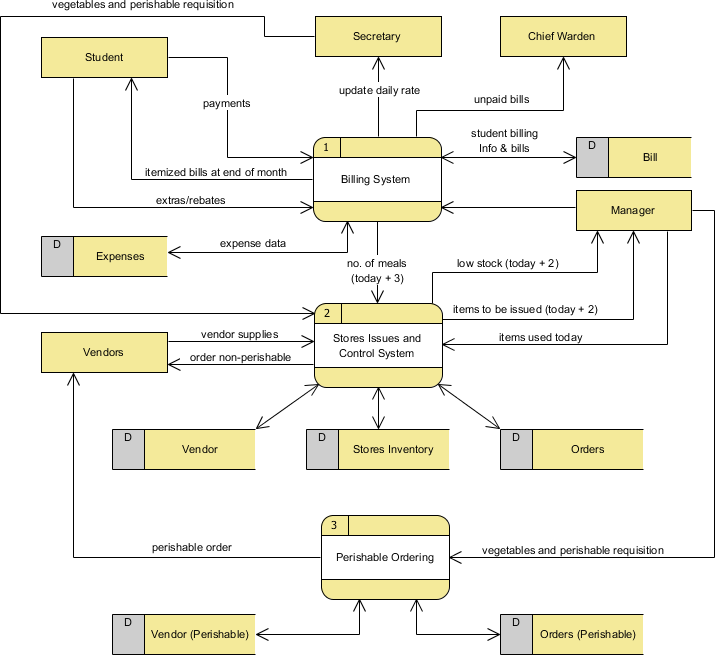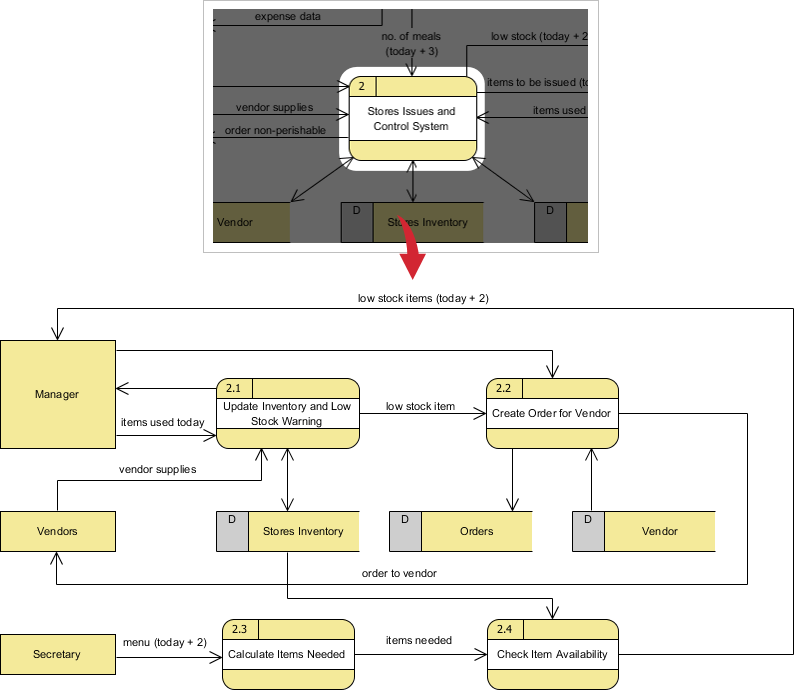Which Of The Following Is Not An Error When Drawing A Data Flow Diagram?

Also known equally DFD, Information menstruum diagrams are used to graphically stand for the flow of data in a business information system. DFD describes the processes that are involved in a system to transfer data from the input to the file storage and reports generation.
Information flow diagrams tin be divided into logical and physical. The logical information flow diagram describes flow of information through a arrangement to perform sure functionality of a business. The physical information flow diagram describes the implementation of the logical information flow.
Draw DFD with the Best DFD tool
Demand to create Information Flow Diagram? Visual Prototype features a professional person DFD editor that enables y'all to create DFDs faster, easier and better. It is an international award-winning modeler, and however it is piece of cake-to-use.
Acquire More than
Why DFD?
DFD graphically representing the functions, or processes, which capture, manipulate, store, and distribute data betwixt a arrangement and its surroundings and between components of a system. The visual representation makes it a expert communication tool between User and System designer. Structure of DFD allows starting from a broad overview and expand it to a hierarchy of detailed diagrams. DFD has ofttimes been used due to the following reasons:
- Logical information flow of the organisation
- Determination of concrete system structure requirements
- Simplicity of notation
- Institution of manual and automated systems requirements
DFD Symbols
There are four basic symbols that are used to represent a data-flow diagram.
Process
A procedure receives input data and produces output with a unlike content or form. Processes can exist every bit elementary as collecting input data and saving in the database, or it tin can be circuitous as producing a written report containing monthly sales of all retail stores in the northwest region.
Every procedure has a name that identifies the function it performs.
The name consists of a verb, followed past a singular noun.
Example:
- Use Payment
- Summate Commission
- Verify Order
Notation
- A rounded rectangle represents a process
- Processes are given IDs for like shooting fish in a barrel referencing

Procedure Case

Data Flow
A data-flow is a path for data to move from 1 part of the information system to another. A data-catamenia may correspond a unmarried data chemical element such the Client ID or it tin represent a set of data element (or a data construction).
Example:
- Customer_info (LastName, FirstName, SS#, Tel #, etc.)
- Order_info (OrderId, Item#, OrderDate, CustomerID, etc.).
Data menstruum Example:

Notation
- Straight lines with incoming arrows are input data flow
- Straight lines with outgoing arrows are output data flows
Notation that:
Because every process changes data from one class into another, at least one data-menses must enter and one information-catamenia must exit each process symbol.
Rule of Data Flow
One of the rule for developing DFD is that all flow must begin with and end at a processing step. This is quite logical, because data can't transform on its own with being process. By using the thumb rule, it is quite easily to identify the illegal data flows and right them in a DFD.
Other frequently-made mistakes in DFD
A second class of DFD mistakes arise when the outputs from ane processing step do not match its inputs and they tin exist classified as:
- Black holes - A processing footstep may have input flows just no output flows.
- Miracles - A processing step may take output flows only no input flows.
- Grey holes - A processing footstep may accept outputs that are greater than the sum of its inputs

Data Shop
A data store or data repository is used in a data-menstruation diagram to represent a state of affairs when the organization must retain data because one or more processes need to apply the stored data in a later time.
Annotation
- Data can be written into the data store, which is depicted by an outgoing pointer
- Data can be read from a data store, which is depicted by an incoming arrow.
- Examples are: inventory, Accounts receivables, Orders, and Daily Payments.

Data Store Example

Annotation that:
- A data store must exist connected to a process with a information-menses.
- Each information store must take at least ane input data-catamenia and at least one output data-flow (fifty-fifty if the output data-flow is a command or confirmation message).
External Entity
An external entity is a person, department, exterior organization, or other information system that provides data to the organisation or receives outputs from the system. External entities are components exterior of the boundaries of the information systems. They stand for how the data system interacts with the exterior globe.
- A rectangle represents an external entity
- They either supply data or receive information
- They do non process data
Notation
- A customer submitting an order and then receive a bill from the system
- A vendor outcome an invoice

External Entity Example

Note that:
- External entities also are called terminators because they are information origins or concluding destinations.
- An external entity must be connected to a process through a data-flow.
Summit-Down Decomposition Techniques
Top-downwardly decomposition, as well called leveling, is a technique used to show more detail in lower-level DFDs. Leveling is done by drawing a series of increasingly detailed diagrams until the desired degree of detail is reached. As shown in the Figure, DFD Leveling is get-go displaying the targeted system as a single process, and then showing more particular until all processes are functional primitives.
Balancing DFD
When performing tiptop-downwardly decomposition to a DFD to lower level DFDs, the inputs and outputs must be conserved betwixt levels of DFDs. For example, level n & n+1 must take the same inputs and outputs

Guideline for Developing Data-Flow Diagram
Context Diagram - Level 0
- The context diagram must fit in i folio.
- The process name in the context diagram should be the name of the information system.
- For instance, Grading System, Order Processing System, Registration System.
- The context level diagram gets the number 0 (level zero).
Unique Proper noun for Levels
- Use unique names within each gear up of symbols.
- For example, in that location can be only one entity CUSTOMER in all levels of the data-flow diagrams; or here can exist but ane procedure named CALCULATE OVERTIME among all levels of data-flow diagrams.
No Cantankerous Line in DFD
- One way to attain this is to restrict the number of processes in a data-flow diagram.
Right Complexity for Human Mind - vii + / - two Symbols
- On lower-level information-flow diagrams with multiple processes, one should non have more than than nine process symbols.
- Another way to avoid crossing lines is to duplicate an external entity or data store. Use a special note such every bit an asterisk, to denote the indistinguishable symbol.
Numbering Convention
- Use a unique reference number for each procedure symbol.
- Other process numbers are in the bureaucracy of:
- (1, two, 3,...);
- (one.one, 1.2, 1.3, ..., 2.1, 2.2, ii.3,...);
- (1.1.1, ane.1.2, 1.1.3,...).
Context-Level Diagram
A context diagram gives an overview and it is the highest level in a data flow diagram, containing just one process representing the entire organization. It should be split up into major processes which give greater detail and each major procedure may farther split up to give more particular.
- All external entities are shown on the context diagram as well as major data flow to and from them.
- The diagram does not contain whatsoever data storage.
- The single process in the context-level diagram, representing the unabridged organization, can be exploded to include the major processes of the system in the side by side level diagram, which is termed as diagram 0.

Level 1 DFD
Processes in diagram 0 (with a whole number) can exist exploded farther to represent details of the processing activities. Case below shows the side by side level ((Diagram 1) of process explosion.
Note that:
Although the following level 1 DFD only has three processes, there are quite a few input and input from the processes to the external entities and that could end up to be a few cross lines among them in the diagram; to avoid this problem, we could use (master and auxiliary view) multiple views of the aforementioned external entity in the DFD.

Level 2 DFD
If a process with a lot of data flow linking between a few external entities, we could commencement excerpt that particular process and the associated external entities into a separate diagram similar to a context diagram, before you refine the procedure into a carve up level of DFD; and past this fashion you can ensure the consistency between them much easier.

Logical vs Physical Data Period Diagrams
Data menstruum diagrams are categorized as either logical or concrete. A logical data flow diagram focuses on the business organization and how the concern operates. It is not concerned with how the system will be constructed. We tin can ignore implementation specifics such equally, computer configuration, information storage engineering science, advice or bulletin passing methods by focusing on the functions performed by the system, such equally, information collection, data to data transformation and information reporting.
A physical data flow diagram shows how the system will exist implemented, including the hardware, software, files, and people in the organisation. It is developed such that the processes described in the logical information flow diagrams are implemented correctly to achieve the goal of the business.
Benefits of Logical Information Flow Diagram
- A logical diagram is drawn present business concern information and centered on business activities, which makes information technology an ideal advice tool when use in communicating with project users.
- Logical DFD is based on concern events and contained of particular applied science or physical arrangement, which makes the resulting system more stable.
- Logical DFD allows analyst to understand the business being studied and to place the reason behind implementation plans.
- Systems implemented based on logical DFD will be easier to maintain because business functions are not subject to frequent change.
- Very ofttimes, logical DFD does non contain data stores other than files or a database, making less complex than physical DFD and is easier to develop.
- Physical DFD can be easily formed by modifying a logical DFD.
Benefits of Concrete Data Period Diagram
- Clarifying which processes are transmission and which are automatic: Manual processes require detailed documentation and automated process require computer programs to exist developed.
- Describing processes in more detail than do logical DFDs: Describes all steps for processing of information.
- Sequencing processes that have to be done in a item order: Sequence of activities that atomic number 82 to a meaningful result are described. For instance, update must exist performed before a producing a summary written report.
- Identifying temporary data storage: Temporary storage such as a sales transaction file for a customer receipt (report) in a grocery store, are described.
- Specifying actual names of files and printouts: Logical information flow diagrams describes actual filenames and reports, then that the programmers can relate those with the information dictionary during the developmental phase of the system.
- Calculation controls to ensure the processes are done properly: These are conditions or validations of data that are to exist met during input, update, delete, and other processing of information.
Refining Physical DFD for Logical DFD
The example beneath shows a logical DFD and a physical DFD for a grocery store cashier:
- The Customer brings the ITEMS to the register;
- PRICES for all ITEMS are LOOKED Upward, and then totaled;
- Adjacent, PAYMENT is given to the cashier finally, the CUSTOMER is given a receipt.
Logical DFD Example - Grocery Store
The logical DFD illustrates the processes involved without going into detail about the concrete implementation of activities.

Physical DFD Example - Grocery Store
- The concrete DFD shows that a bar lawmaking-the UPC Toll lawmaking found on most grocery shop items is used
- In addition, the physical DFD mentions manual processes such as scanning, explains that a temporary file is used to keep a subtotal of items
- The PAYMENT could be made by Greenbacks, Cheque, or DEBIT Bill of fare
- Finally, it refers to the receipt by its name, Cash Register RECEIPT

Source: https://www.visual-paradigm.com/guide/data-flow-diagram/what-is-data-flow-diagram/
Posted by: murphycattat.blogspot.com


0 Response to "Which Of The Following Is Not An Error When Drawing A Data Flow Diagram?"
Post a Comment